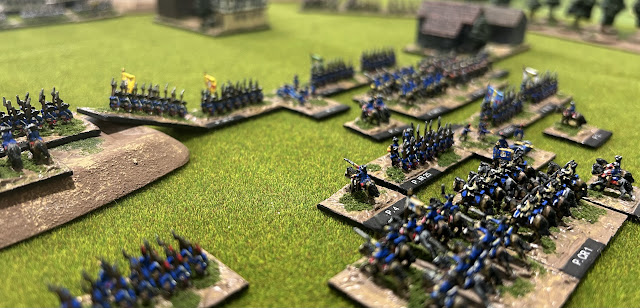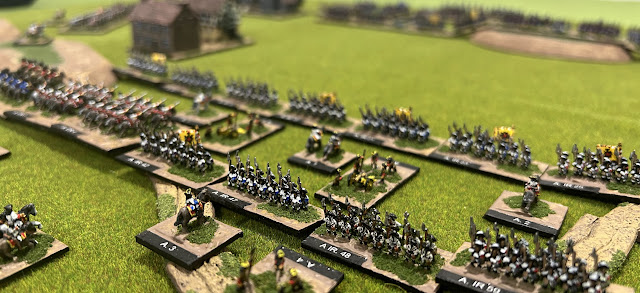The following is a report of our most recent Seven Years War game, a fictional engagement set in 1757. While the battle is an independent action, and not part of a campaign, I have for convenience linked it to an earlier action. For those preferring a short video summary one can be found here.
While Frederick would claim the Battle of Lukositz as a victory the harsh reality was it was a bloody draw which had thrown his invasion of Bohemia into some disarray. Events elsewhere further complicated his planned troop concentration and as such just two weeks following the Battle of Lukositz he faced Browne again. He took comfort that some reinforcements had arrived, making up his losses, but the strategic situation had not improved. In all Frederick had as his disposal 17,000 bayonets, 6,000 cavalry and excluding lighter battalion guns attached to his infantry some 36 cannon. Below, a view of the Prussian centre and right.
By noon on the 27th of April the two armies were deployed. The field on which Browne had offered battle was generally open but bordered in the west and east by several small towns which, at least initially, defined the deployment of both armies. Frederick, positioned in the centre on high ground, now looked south towards the Austrian lines. Before him Browne's army comprised 19,000 bayonets, 6,000 cavalry and numerous cannon.
Above, a view of the Austrian left flank and centre with the cavalry, a mix of dragoons and cuirassiers in the foreground. Below, a view of the Austrian right and centre again viewed from behind the Austrian lines.
On Frederick's right flank, the west, were the towns of Drivice and slightly further south Kralkov. Beyond Kralkov a series of small areas of rising ground broke up the plain. On Frederick's eastern flank was the town of Brestnek, though closer to the Austrian lines than his own. East of Brestnek a small stream meandered southeast. Often boggy this stream provided some protection to the flanks of both armies. Unwilling to make a flanking movement both Browne and Frederick determined that they would seek decisive action in the centre.
While Browne's plan is unknown Frederick determined to focus his main effort against the Austrian right while fighting more defensively on his left. However, to do strengthen his right he needed a strong defensive position. The twin towns of Drivice and Kralkov would, he determined, provide this. Therefore soon after noon Prussian Infantry Regiment 7 surged forward to seize the town of Kralkov. The remaining regiments of Bevern's Division formed slightly north of Kralkov, but from where they could provide close support when required. Further protection of the Prussian right was the task of Ferinand's Division deployed between Drivice and Kralkov in such a way as to prevent Austrian cavalry moving against the advancing Prussian line. Extending Bevern's Division to the east was Manstein's Division. It comprised, like Bevern's Division, some four infantry regiments. Behind these regiments a small infantry reserve was placed as well as the majority of the Prussian cavalry, some four brigades, a mix of dragoons and cuirassiers. On the extreme Prussian left was Zieten's Hussar Division.
Positioned to the rear of Manstein's Infantry Division, on the Prussian left, was Treskow's Converged Grenadier Division. The elements of this division were of course formed from the various grenadier companies from the regiments deployed on the field. Together they formed what was in effect three understrength regiments. It was here that Frederick would attempt to gain his initial breakthrough, if he could draw the Austrians forward.
Browne was not one to hesitate. Soon after the Prussian advance had begun the white clad Austrian regiments countered. Generally the Austrian regiments moved directly forward from their initial positions, though some changes were made. Most obviously were the attacks by Austrian Infantry Regiments 4 and 7 against Kralkov.
Below, the Austrian IR 4 and IR 7 surge forward against Kralkov. Unfortunately for Browne, both regiments were soon thrown back by the Prussian defenders.
The second most notable manoeuvre was that conducted by O'Donnel's Cavalry Division. Positioned on the Austrain left rear this division repositioned to the extreme Austrian left from where it threaten the Prussian right. This powerful division comprised two cuirassier brigades and one dragoon brigade. Below, a view from the extreme Austrian left looking east. O'Donnel's cavalry is in the foreground while Kralkov is on the right.
Finally in the centre several Austrian cannon were massed to support the Austrian infantry advance, which comprised three infantry divisions, each of some 6,000 men. The Austrian artillery once deployed began to bombard the Prussian line some 400 yards distant.
Above, a general view of the battle from the Austrian lines looking northwest with Kralkov on the top left. The Austrian divisions from left to right are Sprecher's Division then Forgach's Division. The Austrian right was stiffened by d'Arberg's Division but that is not shown. In the rear is Prinz Hohenzollern's Cavalry Division, again comprising two cuirassier brigades and one dragoon brigade. Below, a view from the Prussian lines looking southwest.
With the concentration of Austrian cannon against the Prussian centre Frederick ordered his regiments here to retire. As these regiments retired 200 yards, reducing the impact of Austrian cannon fire, he repositioned his infantry against the Austrian left and right. On Frederick's right IR 3 and IR 5 advanced and bolstered by artillery engaged the Austrian infantry left with fire. They were further aided by the garrison of Kralkov who were now engaging the Austrian infantry with musket and light artillery.
Above, a detailed view of IR 3 and IR 5 engaging the Austrians near Kralkov, while below a more general view.
Below, a view from the Austrian perspective, with Austrian IR 12 under extreme pressure and IR 13 and under intermittent fire. All three Austrian regiments, along with IR 4 and IR 7 who failed to take Kralkov earlier are from Sprecher's Division.
However, it was on the Prussian left where the battle gained momentum. The three converged grenadier regiments of Treskow's Division were thrown forward with determination against the Austrian right.
Concentrating on two Austrian regiments IR 25 and IR 26, the Prussian converged grenadiers advanced with confidence, as can be seen above. At first the Austrians held but as casualties mounted they were forced back.
The situation on the Austrian right now became confused. In a series of confusing attacks and counterattacks the Austrian right, despite being reinforced, was soon in disarray. Now the Prussian converged grenadiers extended their attacks falling on the Austrian gun line, as can be seen below.
The advancing Prussian grenadiers were now supported by Prussian hussars added their wait to the pressure on the Austrian right. Below, Prussian hussars and grenadiers attack Austrian IR 24.
Below, the view from the Austrian lines looking northwest. Two regiments of Prussian converged grenadiers can be seen attacking the Austrian gun line. An increasing number of Austrian regiments are disordered, or in some cases routed.
With his right in danger of complete collapse Browne reorganised his lines. The Austrian regiments that had three hours advanced with confidence fell back while Hohenzollern's cavalry covered the retrograde movement from any immediate Prussian advance. In addition O'Donnel's Cavalry Division, which will be recalled had been threatening the Prussian right, was recalled. It was clearly needed in the centre.


















A great AAR Keith. I felt like I was in the midst of the maelstrom. Very atmospheric. Though I'm unhappy that my favoured Austrians suffered at the hands of the dastardly Prussians 🙄!
ReplyDeleteThanks Greg, its always good to get some feedback and your comment indicates my description of the battle was on the money. It really was a great game! As to the Austrians I wouldn't feel too bad for them. They are due some reinforcements who have been sitting in the "to be painted tray" for a while.
Delete